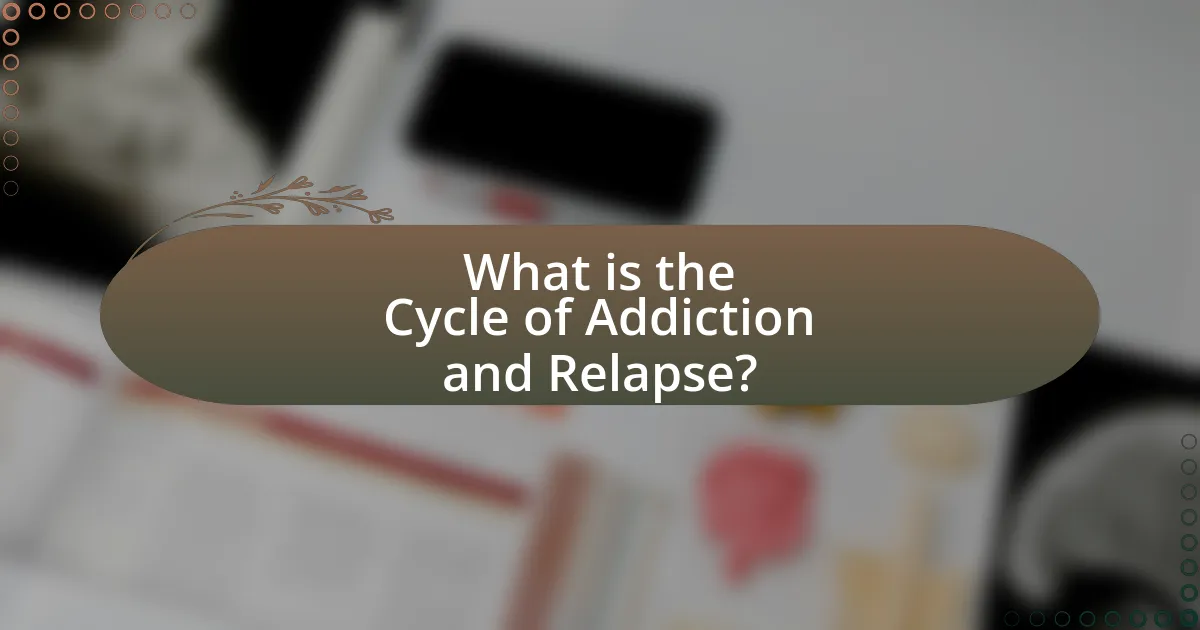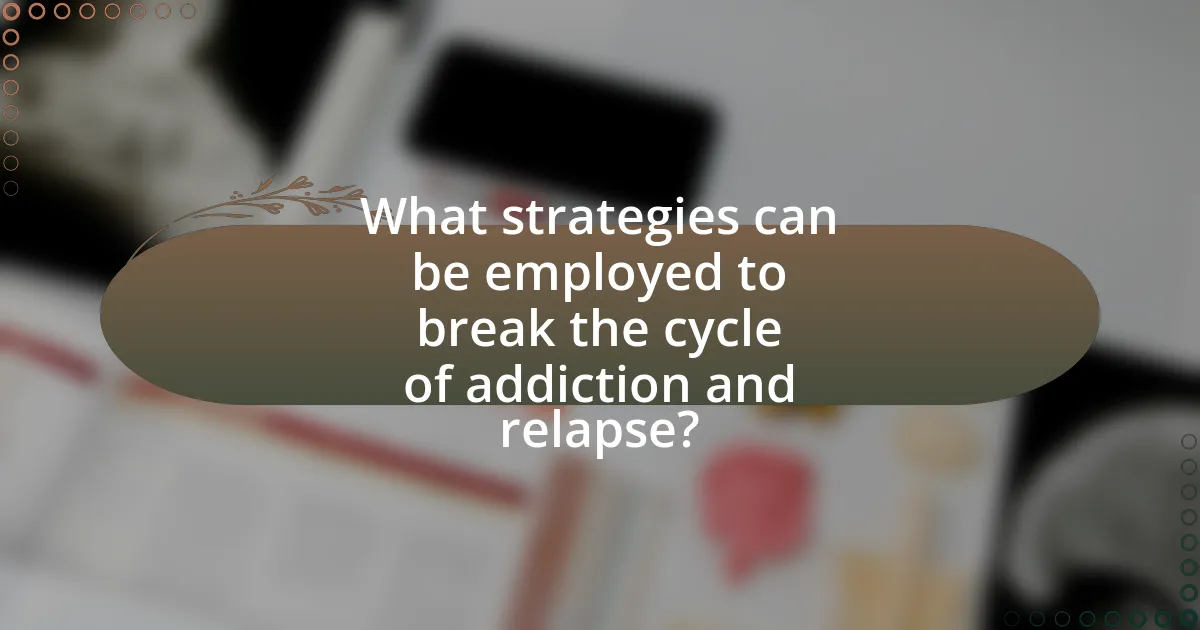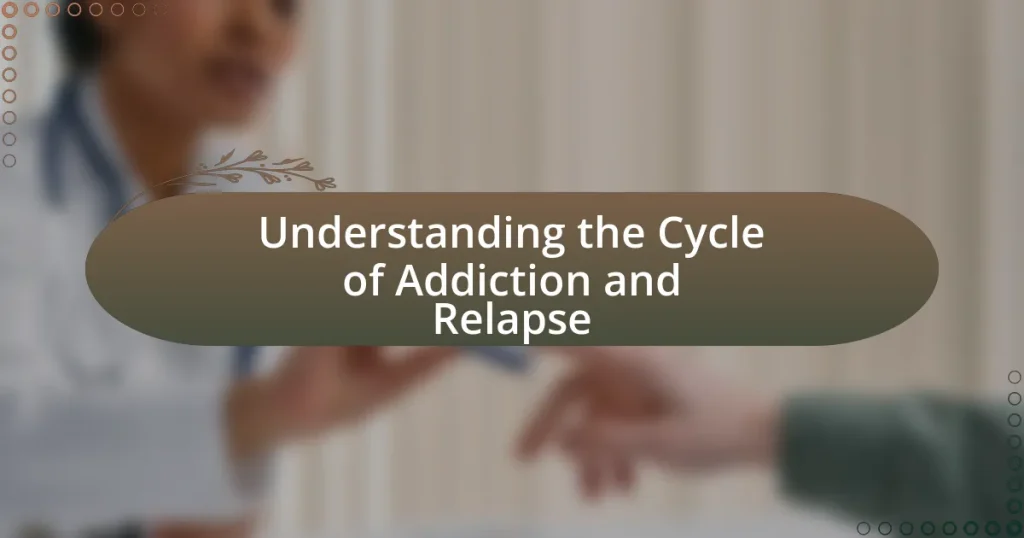The Cycle of Addiction and Relapse is a complex, repetitive process characterized by stages including initial use, increased tolerance, dependence, and relapse. Addiction is defined as a chronic disorder marked by compulsive behavior and significant changes in brain function, often exacerbated by psychological factors such as mental health disorders and stress. The article explores the stages of addiction, the psychological and physiological aspects involved, and the importance of understanding triggers and patterns that lead to relapse. It also discusses effective strategies for breaking the cycle of addiction, including therapeutic approaches, support systems, and educational resources aimed at reducing stigma and promoting recovery.

What is the Cycle of Addiction and Relapse?
The Cycle of Addiction and Relapse is a repetitive process that includes stages such as initial use, increased tolerance, dependence, and eventual relapse. Initially, an individual may experiment with a substance, leading to pleasurable effects. Over time, the body adapts, requiring more of the substance to achieve the same effects, which is known as tolerance. As dependence develops, the individual experiences withdrawal symptoms when not using the substance, reinforcing the cycle. Relapse occurs when the individual returns to substance use after a period of abstinence, often triggered by stress, environmental cues, or cravings. Research indicates that approximately 40-60% of individuals with substance use disorders experience relapse, highlighting the cyclical nature of addiction.
How is addiction defined in psychological terms?
Addiction is defined in psychological terms as a chronic, relapsing disorder characterized by compulsive drug seeking, continued use despite harmful consequences, and long-lasting changes in the brain’s structure and function. This definition is supported by the American Psychiatric Association, which classifies addiction as a mental disorder in the Diagnostic and Statistical Manual of Mental Disorders (DSM-5). The DSM-5 outlines specific criteria for diagnosing substance use disorders, emphasizing the impact of addiction on an individual’s life and the neurobiological changes that contribute to the compulsive behavior associated with addiction.
What are the key characteristics of addiction?
The key characteristics of addiction include compulsive behavior, loss of control, and continued use despite negative consequences. Compulsive behavior manifests as an overwhelming urge to engage in the addictive activity, often overriding rational decision-making. Loss of control refers to the inability to limit the substance use or behavior, even when the individual desires to stop. Continued use despite negative consequences highlights the persistence of the addiction, where individuals ignore harmful effects on their health, relationships, or responsibilities. Research indicates that addiction alters brain function, particularly in areas related to reward and impulse control, reinforcing these characteristics.
How does addiction manifest in different individuals?
Addiction manifests in different individuals through a variety of behavioral, psychological, and physiological symptoms. For example, some individuals may exhibit compulsive drug-seeking behavior, while others may show signs of withdrawal or emotional distress when not using the substance. Research indicates that genetic predisposition, environmental factors, and mental health conditions can influence how addiction presents itself, leading to diverse experiences among individuals. A study published in the journal “Addiction Biology” by Volkow et al. (2016) highlights that variations in brain chemistry and structure can result in different responses to substances, further illustrating the complexity of addiction across individuals.
What stages are involved in the cycle of addiction?
The cycle of addiction involves four main stages: initiation, maintenance, relapse, and recovery. Initiation refers to the initial use of a substance or behavior, often driven by curiosity or social influences. Maintenance occurs when the individual continues to engage in the addictive behavior, leading to dependence and tolerance. Relapse is the stage where the individual returns to the addictive behavior after a period of abstinence, often triggered by stress or environmental cues. Recovery involves the process of overcoming addiction and making lifestyle changes to prevent relapse. Research indicates that understanding these stages can aid in developing effective treatment strategies, as highlighted in the National Institute on Drug Abuse’s findings on addiction as a complex brain disorder.
What are the initial triggers for addiction?
The initial triggers for addiction include environmental factors, genetic predisposition, and psychological influences. Environmental factors such as exposure to substance use in social circles or high-stress situations can lead individuals to experiment with drugs or alcohol. Genetic predisposition indicates that individuals with a family history of addiction are more likely to develop similar issues, as evidenced by studies showing heritability rates of 40-60% for alcohol dependence. Psychological influences, including mental health disorders like anxiety or depression, often drive individuals to seek relief through substance use, further increasing the risk of addiction.
How does the progression of addiction occur?
The progression of addiction occurs through a series of stages that typically include experimentation, regular use, risky use, dependence, and addiction. Initially, individuals may experiment with substances due to curiosity or social influences. As usage becomes more frequent, individuals may develop a tolerance, requiring larger amounts to achieve the same effects. This leads to risky behaviors and negative consequences, yet the individual continues to use the substance. Over time, physical and psychological dependence can develop, characterized by withdrawal symptoms when not using the substance. Ultimately, addiction manifests as a compulsive need to seek and use the substance despite harmful consequences. Research indicates that approximately 10% to 15% of individuals who experiment with substances will develop an addiction, highlighting the significant risk associated with initial use.
Why is understanding the cycle of relapse important?
Understanding the cycle of relapse is important because it helps individuals identify triggers and patterns that lead to substance use. By recognizing these elements, individuals can develop effective coping strategies and interventions to prevent future relapses. Research indicates that approximately 40-60% of individuals recovering from addiction experience relapse, highlighting the necessity of understanding this cycle to improve recovery outcomes. This knowledge empowers individuals to take proactive steps in their recovery journey, ultimately leading to sustained sobriety and better mental health.
What factors contribute to relapse in individuals?
Factors contributing to relapse in individuals include stress, environmental triggers, and lack of social support. Stress can lead to cravings and a desire to return to substance use as a coping mechanism. Environmental triggers, such as being in places associated with past use or being around individuals who use substances, can provoke relapse. Additionally, a lack of social support can leave individuals feeling isolated and more vulnerable to returning to old habits. Research indicates that approximately 40-60% of individuals recovering from addiction experience relapse, highlighting the significance of these factors in the recovery process.
How can recognizing the cycle help in prevention?
Recognizing the cycle of addiction and relapse can significantly aid in prevention by enabling individuals to identify triggers and patterns that lead to substance use. By understanding these cycles, individuals can develop coping strategies and interventions tailored to disrupt the cycle before it leads to relapse. Research indicates that awareness of personal triggers and the cyclical nature of addiction can reduce the likelihood of relapse by up to 50%, as individuals who actively engage in recognizing their patterns are more likely to seek help and utilize support systems effectively.

What are the psychological and physiological aspects of addiction?
The psychological aspects of addiction include compulsive behavior, cravings, and changes in mood and cognition, while the physiological aspects involve alterations in brain chemistry and physical dependence on substances. Compulsive behavior manifests as an inability to control substance use despite negative consequences, driven by the brain’s reward system, which becomes dysregulated. Cravings arise from conditioned responses and neural pathways that reinforce the desire for the substance. Physiologically, addiction leads to changes in neurotransmitter levels, particularly dopamine, which affects pleasure and reward, and can result in withdrawal symptoms when the substance is not available. Research indicates that approximately 40-60% of individuals with substance use disorders experience relapse, highlighting the complex interplay between psychological and physiological factors in addiction.
How do psychological factors influence addiction?
Psychological factors significantly influence addiction by affecting an individual’s susceptibility to substance use and the severity of their dependence. These factors include mental health disorders, such as depression and anxiety, which can lead individuals to use substances as a coping mechanism. Research indicates that approximately 50% of individuals with substance use disorders also have a co-occurring mental health disorder, highlighting the interplay between psychological issues and addiction. Additionally, cognitive patterns, such as impulsivity and risk-taking behavior, can exacerbate the likelihood of developing addictive behaviors. Studies show that individuals with high levels of impulsivity are more prone to substance abuse, as they may struggle to resist immediate rewards despite potential long-term consequences. Thus, psychological factors play a crucial role in both the initiation and maintenance of addiction.
What role do mental health disorders play in addiction?
Mental health disorders significantly contribute to the development and progression of addiction. Individuals with conditions such as depression, anxiety, or PTSD often use substances as a form of self-medication to alleviate their symptoms. Research indicates that approximately 50% of individuals with substance use disorders also have a co-occurring mental health disorder, highlighting the intertwined nature of these issues. This dual diagnosis complicates treatment, as untreated mental health disorders can lead to relapse in addiction recovery, creating a cyclical pattern that is difficult to break.
How does stress impact addiction and relapse?
Stress significantly increases the risk of addiction and relapse by triggering neurobiological changes that enhance cravings and reduce self-control. Research indicates that stress activates the brain’s reward pathways, leading to heightened sensitivity to addictive substances. For instance, a study published in the journal “Nature” by Sinha (2001) found that individuals with a history of substance use disorders exhibited increased cravings and a higher likelihood of relapse when exposed to stressors. This relationship is further supported by evidence showing that stress can lead to dysregulation of the hypothalamic-pituitary-adrenal (HPA) axis, which is associated with addiction behaviors. Thus, stress not only contributes to the initial development of addiction but also plays a critical role in the cycle of relapse.
What physiological changes occur in the brain due to addiction?
Addiction leads to significant physiological changes in the brain, primarily affecting neurotransmitter systems. The most notable change is the alteration of dopamine pathways, where repeated substance use results in reduced dopamine receptor availability and sensitivity, impairing the brain’s reward system. This change contributes to the compulsive behavior associated with addiction, as the brain becomes less responsive to natural rewards. Additionally, addiction can cause structural changes, such as reduced volume in the prefrontal cortex, which is responsible for decision-making and impulse control. Research indicates that these alterations can persist long after cessation of substance use, highlighting the long-term impact of addiction on brain physiology.
How does addiction affect neurotransmitter levels?
Addiction significantly alters neurotransmitter levels, primarily by increasing the release of dopamine, which is associated with pleasure and reward. This heightened dopamine release reinforces addictive behaviors, leading to changes in the brain’s reward circuitry. Over time, chronic substance use can deplete dopamine levels, resulting in reduced sensitivity to natural rewards and contributing to withdrawal symptoms. Research indicates that substances like cocaine and opioids can disrupt normal neurotransmitter functioning, leading to long-term neurochemical imbalances that perpetuate the cycle of addiction and relapse.
What are the long-term effects of addiction on brain function?
Long-term addiction significantly alters brain function, leading to persistent changes in brain structure and chemistry. These alterations can result in impaired decision-making, reduced impulse control, and heightened cravings, which are often linked to changes in the brain’s reward system, particularly in areas such as the prefrontal cortex and the amygdala. Research indicates that chronic substance use can lead to neuroadaptations that diminish the brain’s ability to experience pleasure from natural rewards, a phenomenon known as anhedonia. Additionally, studies have shown that addiction can cause long-lasting deficits in cognitive functions, including memory and learning, due to the impact on neurotransmitter systems, particularly dopamine and glutamate.

What strategies can be employed to break the cycle of addiction and relapse?
To break the cycle of addiction and relapse, individuals can employ strategies such as cognitive-behavioral therapy (CBT), support groups, and medication-assisted treatment. Cognitive-behavioral therapy helps individuals identify and change negative thought patterns and behaviors associated with addiction, which has been shown to reduce relapse rates significantly. Support groups, like Alcoholics Anonymous, provide a community of shared experiences and accountability, which research indicates can enhance recovery outcomes. Medication-assisted treatment, utilizing medications such as methadone or buprenorphine for opioid addiction, has proven effective in reducing cravings and withdrawal symptoms, thereby decreasing the likelihood of relapse. These strategies collectively address the psychological, social, and physiological aspects of addiction, contributing to a more comprehensive approach to recovery.
How can individuals develop coping mechanisms for addiction?
Individuals can develop coping mechanisms for addiction by engaging in structured therapeutic approaches, such as cognitive-behavioral therapy (CBT) and mindfulness practices. These methods help individuals identify triggers, manage cravings, and alter negative thought patterns associated with addiction. Research indicates that CBT can reduce relapse rates by up to 50% by equipping individuals with practical skills to cope with stress and avoid substance use. Additionally, support groups like Alcoholics Anonymous provide community support, which has been shown to enhance recovery outcomes through shared experiences and accountability.
What are effective therapeutic approaches for addiction recovery?
Effective therapeutic approaches for addiction recovery include Cognitive Behavioral Therapy (CBT), Motivational Interviewing (MI), and Medication-Assisted Treatment (MAT). CBT helps individuals identify and change negative thought patterns and behaviors associated with addiction, which has been shown to reduce relapse rates significantly. MI enhances motivation to change by exploring and resolving ambivalence, making it particularly effective in early stages of recovery. MAT combines behavioral therapy with medications to treat substance use disorders, improving treatment retention and reducing cravings, as evidenced by studies indicating that individuals receiving MAT are more likely to remain in treatment and achieve long-term recovery.
How can support systems aid in preventing relapse?
Support systems can significantly aid in preventing relapse by providing emotional support, accountability, and resources for individuals in recovery. Emotional support from family, friends, or support groups helps individuals feel understood and less isolated, which can reduce the likelihood of turning to substances during stressful times. Accountability mechanisms, such as regular check-ins or group meetings, encourage individuals to stay committed to their recovery goals. Additionally, support systems can offer access to resources like counseling, educational materials, and coping strategies, which are essential for managing triggers and cravings. Research indicates that individuals with strong social support networks are less likely to relapse, as evidenced by a study published in the Journal of Substance Abuse Treatment, which found that social support significantly correlates with improved recovery outcomes.
What role does education play in understanding addiction?
Education plays a crucial role in understanding addiction by providing individuals with knowledge about the biological, psychological, and social factors that contribute to addictive behaviors. This understanding helps to demystify addiction, framing it as a complex condition rather than a moral failing. Research indicates that educational programs can significantly reduce stigma associated with addiction, leading to increased empathy and support for those affected. For instance, studies show that individuals who receive education about the neurobiology of addiction are more likely to engage in supportive behaviors and seek help for themselves or others.
How can awareness programs reduce stigma around addiction?
Awareness programs can reduce stigma around addiction by educating the public about the nature of addiction as a complex disease rather than a moral failing. These programs often provide factual information about the biological, psychological, and social factors that contribute to addiction, which helps to shift perceptions and foster empathy. Research indicates that communities with effective awareness initiatives experience a decrease in negative stereotypes and discrimination against individuals struggling with addiction, as evidenced by a study published in the Journal of Substance Abuse Treatment, which found that educational interventions significantly improved attitudes toward people with substance use disorders.
What resources are available for individuals seeking help?
Individuals seeking help for addiction and relapse can access various resources, including support groups, hotlines, and treatment centers. Support groups such as Alcoholics Anonymous (AA) and Narcotics Anonymous (NA) provide community and shared experiences, which are crucial for recovery. Hotlines like the Substance Abuse and Mental Health Services Administration (SAMHSA) National Helpline offer 24/7 confidential assistance and can connect individuals to local treatment options. Additionally, treatment centers provide professional care, including therapy and medical support, tailored to individual needs. According to SAMHSA, over 21 million Americans needed substance use treatment in 2019, highlighting the importance of these resources in addressing addiction.
What practical steps can individuals take to maintain recovery?
Individuals can maintain recovery by establishing a structured routine that includes regular therapy sessions, support group participation, and healthy lifestyle choices. Engaging in therapy, such as cognitive-behavioral therapy, helps individuals address underlying issues and develop coping strategies. Support groups, like Alcoholics Anonymous or Narcotics Anonymous, provide community and accountability, which are crucial for long-term recovery. Additionally, adopting a healthy lifestyle, including regular exercise and balanced nutrition, has been shown to improve mental health and reduce relapse rates. Research indicates that individuals who actively participate in recovery programs and maintain a supportive network have significantly higher success rates in sustaining their recovery.
